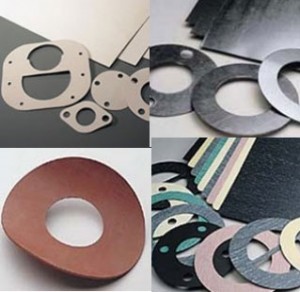What can cause a gasket to fail?
Gasket failure occurs when the steam medium is allowed to leak above the acceptable level as measured by the end user and is not able to be corrected by tightening the joint further. The failure can be attributed to many factors including but not limited to:
- Improper Gasket Thickness
- Improper Gasket Material
- Incorrect Gasket Preload
- Uneven Gasket Load
- Improper Bolted Joint Assembly
- Improper Gasket Dimensions
- Oxidation
- Post Vulcanization
This tech talk will further discuss these issues and what can be done to help avoid the misapplication or improper installation of sheet gasket material in steam service.
What is the proper gasket thickness?
The best answer to this question is that the proper gasket thickness is the thinnest possible gasket. This is because a thinner gasket has less surface area (thickness x ID) exposed to the medium. The minimum stress required to seal decreases with thickness; thinner gaskets have superior load bearing resistance, undergo less creep relaxation than thicker ones, and tend to be less expensive. If flange surfaces are of the proper surface finish, or have recently been refinished, a 1/16” or thinner gasket is recommended. A thicker gasket material may be necessary if a flange has been damaged or has imperfections which a thinner gasket cannot seal and the flanges cannot be resurfaced.
What is the correct gasket material?
Gasket material depends on three criteria; medium, temperature, and pressure. PTFE, Rubber, Graphite, and Synthetic Fiber gaskets all have different chemical resistance, temperature limits, and maximum allowable pressures. Great care should be taken when selecting a gasket material for steam service. Often times a hard fiber non-asbestos gasket material is chosen due to lower cost, but it is not the best choice in saturated steam. For saturated steam service graphite sheet is the superior gasket material. Creep relaxation is less (<5%) than PTFE/Rubber/Synthetic Fiber, is not susceptible to post vulcanization and tends to not dry out and harden like these other materials. In higher pressure and temperature applications a semi-metallic/graphite gasket may be used for increased blowout resistance and to mitigate graphite oxidization. In all cases the PxT chart for a given gasket material should be consulted when deciding whether or not it is suitable for a particular service or application.
Correct initial preload? Correct gasket seating stress?
When installing a gasket there is a minimum preload/stress that must be applied to ensure the initial seal. Any combination of gasket relaxation, bolt relaxation, or incorrect initial preload (under/over/uneven compression) cause leakage over time resulting in failure of the gasket.
A good example of incorrect compression/uneven loading is displayed in Figure 3. The nominal thickness of the gasket was initially 0.125”. After being removed from service and assuming proper preload the final thickness should have been approximately 0.084”-0.086”. It is obvious from the readings of 0.984”, 0.974”, 0.947”, and 0.797”that there were parts of the gasket that were over compressed, while other spots were under compressed, resulting in uneven loading around the gasket.
What does proper bolted joint assembly mean?
Following a guideline or procedure is crucial in ensuring that the joint is prepared and gasket is installed properly. Examples of applicable guidelines are: ASME PCC-1-2013, Guidelines for Pressure Boundary Bolted Flange Joint Assembly, or European standard EN 1591-4:2013. PCC-1 provides recommendations for training skilled assembly personnel, cleaning and examining flange/fastener surfaces, alignment of flanged joints, installation of the gasket, lubrication of fastener surfaces (nuts/studs/through hardened flat washers), installation of fasteners, numbering and tightening sequence of fasteners, and target torque determination. Installing a gasket between two flanges is highly influenced by a written procedure where the technician signs off on the completion of the steps; the end result is the difference between a leak free joint and a joint that leaks immediately or shortly after start up.
What are Oxidation & Post Vulcanization?
Oxidation is a process that occurs in a gasket at elevated temperature, whereby oxygen attacks the gasket material and volatilizes it. The material burns off leaving cracks and voids in the material. This is especially prevalent when a full face gasket is installed between raised face flanges, where the gasket surface outside of the raised face is exposed to hot atmosphere. Post vulcanization occurs at elevated temperatures in gaskets with rubber binders and sulfur curatives. Prolonged exposure to high temperature causes polymerization to continue, cross linking the polymer chains and strengthening the product until it becomes glass like and brittle in nature. These two factors along with excessive gasket creep are why graphite sheet gasket material is the preferred material in saturated steam service over nitrile bound fibrous sheet.








